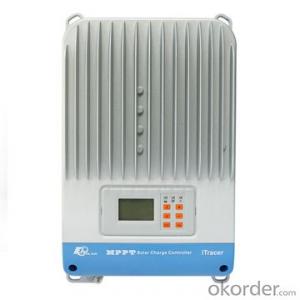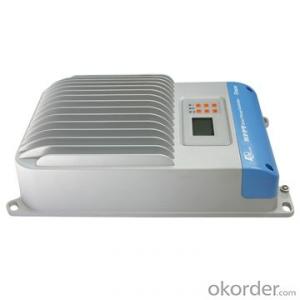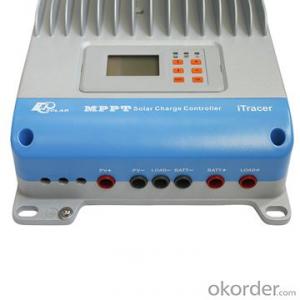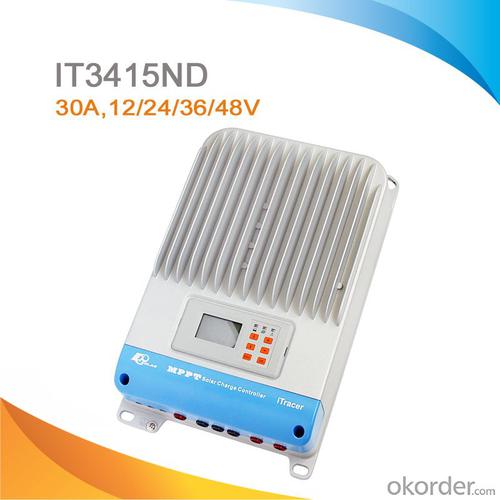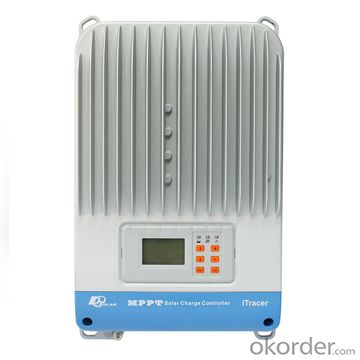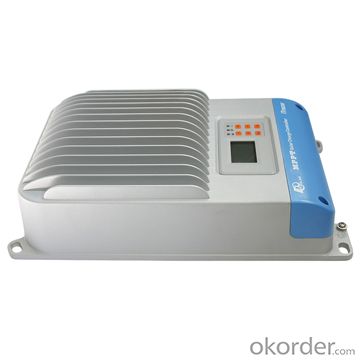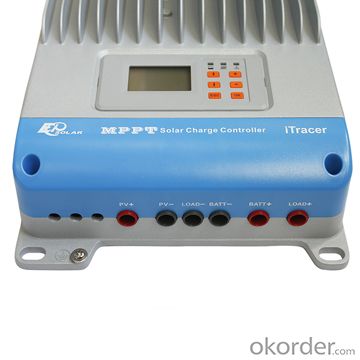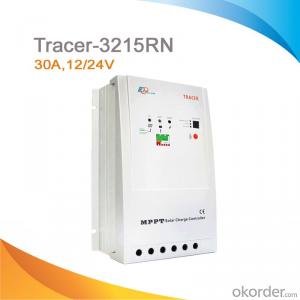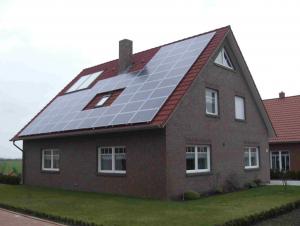iTracer Series MPPT Solar Charge Controller/Solar Battery Charge Regulator for Solar Power System
- Loading Port:
- Tianjin
- Payment Terms:
- TT or LC
- Min Order Qty:
- 30 watt
- Supply Capability:
- 10000 watt/month
OKorder Service Pledge
OKorder Financial Service
You Might Also Like
iTracer is an industrial grade product with advanced Maximum Power Point Tracking (MPPT) algorithm. It can deliver the maximum available power for charging batteries and charge a lower nominal voltage battery from a higher nominal voltage array.
Features:
• Advanced MPPT algorithm with the max. tracking efficiency of 99%
• Multi-phase synchronous rectification technology realizing peak conversion efficiency 98%
• Dual-core(ARM CPU+DSP) control architecture improves the system response speed and optimizes the performance of the system
• Multiphase control technology, optimizes charging current smoothness, reduces ripple and improves the system efficiency
• 128*64 dot-matrix LCD intuitively displays data and state, 6 buttons combinations for easy operation
• Four battery type options: Sealed, Gel, Flooded and User-defined
• Energy statistics recording, it is convenient for users to view charging and discharging energy of each day, month, year and total value.
• Diversified load control mode
• Programmable battery management parameters
• Built-in running data and event logging, max. 15 months
• Extensive communication capabilities (RS232,RS485 with Modbus protocol, CAN Bus extendable)
• PC software available for real time monitoring and parameter setting
• Field upgradable firmware
Electronic Protections:
• PV short circuit protection
• PV overvoltage protection
• PV over current protection
• PV reverse polarity protection
• Reverse current protection at night
• Over temperature protection
• Battery reverse polarity protection
• Load overload protection
• Load short circuit protection
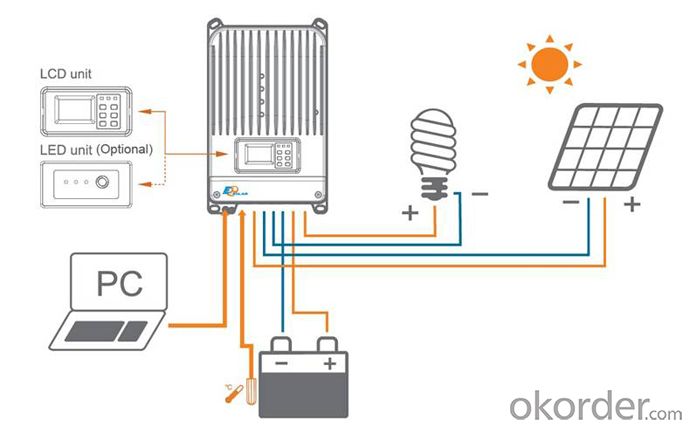
Specification:
Model | IT3415ND | IT4415ND | IT6415ND |
Rated system voltage | 12V/24V /36V/48V auto work | ||
Rated battery current | 30A | 45A | 60A |
Rated load current | 30A | 45A | 60A |
Max. PV open circuit voltage | 150V | ||
Voltage range | 8~72V | ||
Max.PV input power | 400W (12V) | 600W (12V) | 800W (12V) |
800W (24V) | 1200W (24V) | 1600W (24V) | |
1200W (36V) | 1800W (36V) | 2400W (36V) | |
1600W (48V) | 2400W (48V) | 3200W (48V) | |
Self-consumption | 1.4~2.2W | ||
Equalize charging voltage | Sealed: 14.6V, Flooded: 14.8V, User-defined: 9~17V | ||
Boost charging voltage | Gel: 14.2V, Sealed: 14.4V, Flooded: 14.6V, User-defined: 9~17V | ||
Float charging voltage | Gel /Sealed /Flooded: 13.8V, User-defined: 9~17V | ||
Low voltage reconnect voltage | Gel /Sealed /Flooded: 12.6V, User-defined: 9~17V | ||
Low voltage disconnect voltage | Gel /Sealed /Flooded: 11.1V, User-defined: 9~17V | ||
Grounding | Common negative | ||
Tracking efficiency | 99% | ||
Peak conversion efficiency | 98% | ||
Dimension | 358x219x102mm | 382x231x107mm | 440x231x110mm |
Terminal | 25mm2 | 35mm2 | 35mm2 |
Net Weight | 3.7kg | 4.6kg | 5.9kg |
Working temperature | -25℃~+55℃ | ||
Storage temperature range | -30℃~+85℃ | ||
Humidity | 95% NC | ||
Enclosure | IP20 | ||
FAQ:
Q1. What is the voltage?
A1. Our 45/60A solar charge controller is 12/24/36/48V auto work.
Q2. What is the difference between MPPT&PWM?
A2. MPPT has higher efficiency, it can track the max power point and won't waste energy.
Q3. What is the efficiency of the MPPT controller?
A3. MPPT>99%, peak conversion efficiency>98%.
Q4. What is the waranty of product?
A4. 12 months.
Q5. What protection does your MPPT controller have?
A5. PV array short circuit, PV reverse polarity, Battery reverse polarity, Over charging, Output short circuit.
- Q: How does a solar controller handle battery balancing?
- A solar controller handles battery balancing by monitoring the charging and discharging of individual batteries in a battery bank. It ensures that each battery receives an equal amount of charge and prevents overcharging or undercharging of any battery. The controller adjusts the charging current and voltage levels to maintain a balanced state among the batteries, maximizing their lifespan and overall performance.
- Q: What is the maximum number of charging stages supported by a solar controller?
- The maximum number of charging stages supported by a solar controller can vary depending on the specific model and manufacturer. However, many solar controllers typically support up to three charging stages: bulk charging, absorption charging, and float charging.
- Q: Can a solar controller be used with a battery bank that is connected in parallel?
- Yes, a solar controller can be used with a battery bank that is connected in parallel. The solar controller regulates the charging process of the batteries by controlling the amount of current flowing from the solar panels to the batteries. Whether the batteries are connected in parallel or series, the solar controller will still be able to monitor and regulate the charging process effectively.
- Q: Can a solar controller handle power surges from the generator?
- No, a solar controller is not designed to handle power surges from a generator. Its main function is to regulate and control the flow of power from a solar panel to the battery, and it may not have the capacity or protective features to handle sudden spikes in power from a generator. It is recommended to use a separate surge protector or voltage regulator specifically designed for generator systems.
- Q: Can a solar controller be used with solar street lights?
- Yes, a solar controller can be used with solar street lights. A solar controller helps regulate and optimize the charging of the batteries connected to the solar street lights. It ensures that the batteries receive the right amount of solar energy and prevents overcharging or discharging. This helps prolong the lifespan of the batteries and enhances the performance of the solar street lights.
- Q: Can a solar controller be used with both battery-based and grid-tied solar systems?
- Yes, a solar controller can be used with both battery-based and grid-tied solar systems. A solar controller, also known as a charge controller, is responsible for regulating the flow of electricity from the solar panels to the batteries or grid. In a battery-based solar system, the controller ensures that the batteries are charged efficiently and prevents overcharging or damage to the batteries. In a grid-tied solar system, the controller helps regulate the electricity flow from the solar panels to the grid, ensuring that the energy is being used efficiently and conforming to the grid's requirements. Therefore, a solar controller can be used in both battery-based and grid-tied solar systems to optimize energy production and usage.
- Q: How does a solar controller handle reverse current protection?
- A solar controller handles reverse current protection by incorporating diodes that prevent current from flowing back into the solar panels during periods of low or no sunlight. These diodes only allow current to flow in one direction, ensuring that the solar panels are protected from potential damage.
- Q: How does a solar controller handle battery state of charge monitoring?
- A solar controller handles battery state of charge monitoring by continuously measuring the voltage and current flowing into and out of the battery. It uses this data to determine the battery's state of charge and adjusts the charging or discharging process accordingly. Additionally, some advanced solar controllers may employ algorithms or sensors to consider factors like temperature and load demand to provide more accurate monitoring and control of the battery state of charge.
- Q: How does a solar controller handle variations in solar panel shading?
- A solar controller handles variations in solar panel shading by employing a technology called maximum power point tracking (MPPT). MPPT allows the controller to constantly monitor the shading conditions and adjust the voltage and current to the solar panel accordingly, ensuring that the panel operates at its maximum power output despite the shading. This helps optimize the overall efficiency and performance of the solar system.
- Q: What is the maximum voltage drop allowed between the solar panels and the load?
- The maximum voltage drop allowed between the solar panels and the load depends on several factors such as the specific application, the distance between the panels and the load, and the electrical requirements of the load. In general, it is advisable to minimize voltage drop as much as possible to ensure maximum efficiency and performance of the solar power system. A higher voltage drop can lead to power loss, reduced output, and decreased overall system effectiveness. For most solar installations, a commonly accepted maximum voltage drop is around 2-3% of the total system voltage. This means that if the solar panels are operating at 100 volts, the maximum voltage drop allowed would be around 2-3 volts. However, it is important to note that specific guidelines and requirements may vary depending on the application and local electrical codes. It is recommended to consult with a qualified solar installer or engineer who can assess the specific parameters of the system and provide accurate guidance on the maximum voltage drop allowed for that particular setup.
Send your message to us
iTracer Series MPPT Solar Charge Controller/Solar Battery Charge Regulator for Solar Power System
- Loading Port:
- Tianjin
- Payment Terms:
- TT or LC
- Min Order Qty:
- 30 watt
- Supply Capability:
- 10000 watt/month
OKorder Service Pledge
OKorder Financial Service
Similar products
Hot products
Hot Searches
Related keywords

